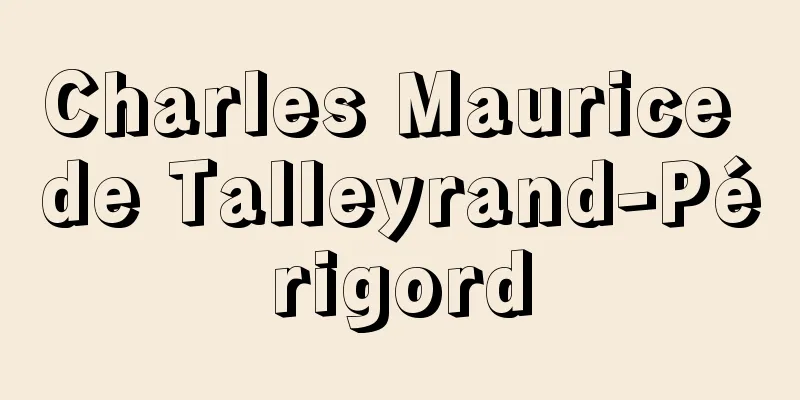Charles Maurice de Talleyrand-Périgord

|
French politician and diplomat. Born on February 13, 1754, as the eldest son of a distinguished aristocrat, he gave up his military career after injuring one leg in a childhood accident and studied at the Saint-Sulpice Seminary. He became the Bishop of Autun in Burgundy in 1788 due to his family background, but he was attracted to political reform and became a member of the Estates General just before the Revolution. As a constitutional monarchist, he cooperated with Mirabeau, and in 1789, he proposed nationalizing church property and became President of the National Assembly (1790), but was excommunicated by the Pope. In 1792, he was sent as an envoy to England and decided to seek exile, staying in England and then America. He returned to France in 1796 and became Foreign Minister of the Directory the following year in 1797, but gave up on the Directory and resigned in 1799, becoming Foreign Minister again immediately after the coup of 18 Brumaire in the same year, in which he played a part. He placed more importance on the balance of power and peace in Europe than on a French victory, and tried to achieve reconciliation with Britain and Austria. After the establishment of the Empire (1804), he also served as Grand Chamberlain to Napoleon I (1804-1808), but he became increasingly disillusioned with Napoleon's warlike policies and resigned as Foreign Minister in 1807, plotting Napoleon's downfall. When the Bourbon dynasty was restored in 1814 thanks to the efforts of Talleyrand, he was appointed Foreign Minister in recognition of his achievements, and by advocating orthodoxy at the Congress of Vienna and skillfully exploiting the conflicts of interest between the great powers, he made a great contribution to the restoration of France's international standing. After Napoleon's Hundred Days (March-June 1815), he served as Prime Minister for a short period (two and a half months), but resigned due to pressure from the far-right. During the July Revolution of 1830, he contributed to the accession of Louis Philippe of the House of Orléans to the throne, and helped Belgium achieve independence as ambassador to Britain (1830-1834). In 1838, he was diagnosed with pulmonary gangrene and underwent surgery on May 14th. The condition worsened, and he died on the 17th of the same month. Just before his death, he became Catholic again, but his life was marked by the pursuit of all kinds of worldly pleasures. It is generally believed that the painter Delacroix was his illegitimate child. [Tetsuya Hirase] "A Biography of Talleyrand, by Duff Cooper, translated by Yasunobu Somura (1963, Chuokoron-Shinsha)" [References] | | | | | | |1807 Oil on canvas Paris Museums "> Prud'hon's "Portrait of Talleyrand" Source: Shogakukan Encyclopedia Nipponica About Encyclopedia Nipponica Information | Legend |
|
フランスの政治家、外交官。名門貴族の長男として1754年2月13日生まれたが、幼時の事故で片足を痛めたため軍人の道を断念し、サンシュルピス神学校に学んだ。家柄の力で1788年ブルゴーニュのオータンの司教となるが、政治改革に心ひかれて、大革命直前、三部会聖職身分議員となる。立憲君主主義者としてミラボーに協力し、1789年、教会財産国有化の提案者となり、国民議会議長(1790)となるが、教皇に破門された。1792年使節としてイギリスに派遣されて亡命を決意し、イギリスついでアメリカに滞在した。1796年に帰国し、翌1797年総裁政府の外相に就任するが、総裁政府に見切りをつけ1799年に辞任し、自らも一役買った同年のブリュメール一八日のクーデター直後ふたたび外相となった。フランスの勝利よりもヨーロッパの勢力均衡と平和を重視する彼はイギリス、オーストリアとの和解に努めた。 帝政成立(1804)後はナポレオン1世の侍従長(1804~1808)を兼ねたが、しだいに彼の好戦的政策に失望して1807年外相を辞任し、ナポレオンの没落を画策した。1814年タレーランの尽力によりブルボン王朝が復活すると、功を買われて外相に起用され、ウィーン会議では正統主義を唱え、列強の利害の対立を巧みに利用してフランスの国際的地位の復活に多大の貢献をした。ナポレオンの百日天下(1815年3~6月)ののち短期間(2か月半)首相を務めたが、極右派の圧力により辞任した。 1830年の七月革命ではオルレアン家のルイ・フィリップの即位に貢献し、駐英大使(1830~1834)としてベルギーの独立を助けた。1838年肺壊疽(えそ)との診断を受け、5月14日手術。経過悪く同月17日死去。死の直前ふたたびカトリックとなったが、その生涯はあらゆる現世的快楽の追求に彩られていた。なお、画家ドラクロワは彼の隠し子であったというのが通説である。 [平瀬徹也] 『ダフ・クーパー著、曽村保信訳『タレイラン評伝』(1963・中央公論社)』 [参照項目] | | | | | | |1807年 油彩ParisMusées"> プリュードン『タレーランの肖像』 出典 小学館 日本大百科全書(ニッポニカ)日本大百科全書(ニッポニカ)について 情報 | 凡例 |
>>: Dahlem Museum of Art - Dahlem Museum (English name)
Recommend
Kichu - Kichu
...This shortened the time distance to Keihanshin...
Product planning
Also called product planning. This is the activity...
al-Zuhri (English spelling)
...This is the first Islamic jurisprudence. The b...
Agathias - Agathias (English spelling)
Byzantine poet and historian. Born in Myrina in A...
Arthur Hendrick Vandenberg
1884‐1951 American Republican politician. Born in ...
Catnip - Catnip
...The dried leaves and flower stalks are used fo...
Hunedoara (English spelling)
An industrial city in Hunedoara County in western...
Federated States of Micronesia - Mikuroneshiarempou (English spelling)
A federal state located in the Caroline Islands i...
Petroleum ether (English spelling)
A colorless, transparent petroleum product with a...
Hiwa [town] - Hiwa
A former town in Hiba County in northern Hiroshima...
Angle gauge
This is a standard gauge for measuring angles. Li...
Fédération internationale de l'automobile (English: Federation internationale de l'automobile)
…At that time, Hitler favored Benz, and Mussolini...
Administrative investigation - administrative investigation
(1) The activity of collecting, organizing, and an...
Schizanthus - Schizanthus
A semi-winter-hardy annual plant of the nightshad...
Karatsu Kiln
…At the end of the 16th century, multi-chambered ...






![Esashi [city] - Esashi](/upload/images/67cb0625a4011.webp)


